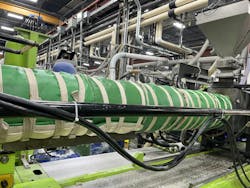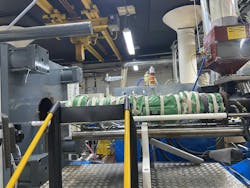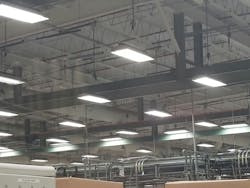By Bruce Geiselman
The plastics industry is a "target-rich environment when it comes to energy efficiency," said APenergy consultant Matt Flanigan, and incentive programs could partially or fully pay for improvements that save processors money and reduce carbon emissions.
“There are essentially three different paths in industrial plants for energy efficiency,” said Flanigan, director of APenergy. “Those paths are process cooling, compressed air, or improvements in the process itself, and the plastics industry has all three.”
APenergy helps industrial plants not only identify energy savings opportunities and install the necessary equipment but also apply for and obtain funding assistance from utility incentive programs. About 40 percent of APenergy’s clients are plastics processors, and the company has helped plastics processors reduce their carbon emissions by about 6,400 tons over the past 15 years, Flanigan said.
When it was founded in 1986 as Air Power USA, the company specialized in helping industrial clients eliminate inefficiencies and leaks in their compressed air systems. However, over the years, the company has expanded to a full range of energy-efficiency initiatives.
“When we go into a plant, we take our blinders off, and we’re looking for anything that we can do to help a company use less energy,” Flanigan said.
The investment with the quickest return is the installation of insulation blankets on molding machines.
“It’s the most cost-effective thing I have ever seen,” he said.
While savings vary by machine and depend on multiple factors, including the cost of electricity, “as a general rule, without incentives, it pays back in less than one year,” he said.
On most energy improvement projects, APenergy works with mechanical and electrical contractors to install upgrades. However, when it comes to insulation blankets, APenergy offers turnkey services — including measuring machines and installing the proper-size blankets. Blanket manufacturers typically ask plastics processors to measure their own equipment and install the blankets themselves, but many processors lack the staff and experience to do so, Flanigan said.
“That’s cumbersome for a lot of companies,” he said. “There is us and maybe one other company in the country that will do these blankets on a turnkey basis. … I’m busting at the seams doing this turnkey blanket stuff because no one else will do it. Not only do we do it, on many occasions, we do it without any cost to the customer because we do it for the incentives.”
Insulation blankets are commonly installed on the barrels of injection molding machines.
“You have to be careful with extruders because many extruders are fan-cooled, and you can’t put blankets on fan-cooled extruders,” Flanigan said.
Another area APenergy is beginning to explore for boosting energy efficiency is the installation of new high-efficiency heater bands for the barrels.
“Every day, I hear something new,” Flanigan said. “These new high-efficiency heater bands are radiant heater bands instead of just resistance heater bands that have been used for years and years and years. They’re much more efficient than the existing heater band technology. It’s another arrow in the quiver for me.”
Improving the cooling process also can yield major energy savings. APenergy recently completed an upgrade to a chiller system at a plastics plant in the Chicago area. The chiller system redesign is saving “a number of gigawatt hours of energy,” Flanigan said.
Processors with older chiller systems might consider an upgrade, he said.
“Chiller efficiency has made dramatic improvements the last 20 years, and the life of a chiller is probably 25-plus years,” Flanigan said. “If you go into a plant that has a 20- to 25-year-old chiller, you can improve the efficiency of that chiller, but you really need to do other things to make the chiller project cost-effective because chillers are expensive. You can do things like adding free cooling to the system, which is simply adding a mechanism, typically either a [water] cooling tower or a dry cooler, to the system that allows you to turn the compressor off in those months when you still have to cool your process down, but you really don’t need a compressor to do it because you have outside air temperatures that will do the cooling for you. The hours per year that you can shut that chiller off is easy savings, and it’s a very cost-effective measure.”
Installing variable-frequency drives (VFDs) on pumps used in a cooling system also offers enormous potential for savings, he said. VFDs accurately match a chiller's motor performance to the actual cooling load requirement.
Another way to make chillers more efficient is to improve the pipes running throughout a plant or to correct problems that have developed over the years.
“Oftentimes, when we go into plants, we’ll find messes in piping,” Flanigan said. “Things that have been monkeyed with over the last 20 to 25 years need to be undone to set the system back to working properly. All of those things together make a really nice, cost-effective project that utilities will pay a big chunk of the cost for.”
Compressed air systems remain a focus for APenergy.
“We understand multiple opportunities in compressed air, both on the supply side and the demand side,” Flanigan said. “You can put new compressors in, but there is a whole lot more to it than that.”
Fixing leaks in such systems is the most obvious opportunity to improve their energy efficiency. For instance, APenergy might find compressors producing 125 pounds of pressure when only 95 pounds of pressure is required to meet a plant’s needs for functions including conveying, cooling and molding.
“The cost of a leak can be hundreds and sometimes thousands of dollars per year,” Flanigan said.
Before replacing an air compressor, plants should identify and fix leaks, he said.
Another common energy waste is using compressed air for inappropriate purposes. For example, he has seen plastics processors put a compressed air tube into a water bath to aerate the water to cool plastic parts as they come off a line.
“I see that happen in a lot of plants, but it really is the most expensive way of trying to do that,” Flanigan said. “We talk [with clients] about inappropriate uses of compressed air, getting the air pressure right, and eliminating pressure drops.”
Using water from a central chiller is a more efficient way of cooling plastic parts, he said.
Sometimes, APenergy recommends replacing old hydraulic injection molding machines, or upgrading existing machines with more-modern technology.
“All kinds of plastic molding equipment has implemented the use of servo-electric motors over hydraulics, which is a quantum leap forward in efficiency,” Flanigan said. “We work with one partner that will retrofit an old hydraulic molding machine and put in a new servo-electric pump that essentially turns that injection molding machine from all-hydraulic into a hybrid injection molding machine, and he can do it at a fraction of the cost of buying a new unit. He’s successfully retrofitted dozens of injection molding machines with servo-electric pumps, and we’ve helped them get incentives on a number.”
Before filing for incentive, plastics processors must be able to show that they have achieved energy savings through an applicable upgrade.
Obtaining incentives involves measuring the energy efficiency gained from a plant upgrade, which isn’t as easy as it might seem.
“As a general rule, we put kW (kilowatt or power) meters on a piece of equipment so that you can get granularity,” Flanigan said. “Sometimes, it’s on just a part of the piece of the equipment that you’re affecting so that you can get really granular in your analysis. Then, you take your pre-data and your post-data, you calculate the difference between the two, and then you must ‘normalize’ it. You take the production of the piece of equipment before, and the production of the piece of equipment after, and then you pull all those calculations together to determine the energy efficiency [gain]. The calculation is the kWh per pounds of product produced.”
The incentives available to plastics processors for undertaking energy efficiency projects vary widely. Forty-four states offer incentive programs, but some are more generous than others.
“I’ve seen incentives as low as 3 cents a kilowatt hour. I’ve seen incentives as high as 65 cents a kilowatt hour. One incentive is more than 20 times higher than the other incentive. It depends on where you’re at,” Flanigan said. “Utility incentives are very parochial and managed by the states. The federal government has no input into the process because utilities are governed by state public service commissions. The public service commissions in each state determine whether to mandate these incentive programs. The utilities would never do it themselves.”
The states with the most-generous incentive programs include Illinois, Connecticut, Massachusetts, Oregon, Washington, Arkansas, Maryland and New Jersey, Flanigan said. Meanwhile, Ohio, Alabama, North Dakota, South Dakota, Kansas and West Virginia don’t offer electric utility incentives, he said.
Undertaking energy-saving projects that are reimbursed by utilities at 100 percent doesn’t happen every day, but it’s not that unusual, Flanigan said.
“Over half the time, we’re able to find stuff that’s so cost-effective that we can pay for the whole project. Most utilities limit what we can do. They put a cap on the project cost that they will pay for. A lot of places, it’s 50 percent, in some places it is 70 or 75 percent, and in a few places, like Illinois and Arkansas, it is 100 percent, which is why we spend a lot of our time in Illinois and Arkansas,” Flanigan said.
Even in the half-dozen states without incentives, APenergy works with clients, especially on projects, like installing insulation blankets, that offer a quick return on investment.
“We do take cash from customers,” Flanigan said.
Contact:
APenergy, Gahanna, Ohio, 740-862-4112, https://apenergy.com
About the Author
Bruce Geiselman
Senior Staff Reporter Bruce Geiselman covers extrusion, blow molding, additive manufacturing, automation and end markets including automotive and packaging. He also writes features, including In Other Words and Problem Solved, for Plastics Machinery & Manufacturing, Plastics Recycling and The Journal of Blow Molding. He has extensive experience in daily and magazine journalism.


